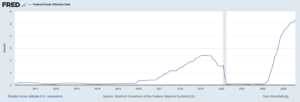It is no secret that the single-family rental industry has seen a significant slowdown in activity this year. Part of this is due to the abnormally large activity we saw over the last 2 years – anything compared to those numbers will seem small. But of course, the major factor at play is the increased interest rates set by the Federal Reserve in their effort to tamper down inflation.
Two Charts
To see the impact of the increase in action, we looked at two charts:
1) The Federal Effective Funds Rate from the St. Louis Fed
2) A Google Trends chart of the search term “FOMC” (Federal Open Market Committee – the committee that meets throughout the year to set the rate).
The correlation starting in Q2 2022 is obvious. Interestingly, the search term “FOMC” did not tick up when the Fed started slowly increasing the rates before the pandemic, it only gained popularity when the dramatic increases started to counteract the rapid rise in inflation.

Federal Funds Effective Rate: Jan 1, 2010 – Sep 27, 2023

Google Trend for Search Term “FOMC”: Jan 1, 2010 – Sep 27, 2023
Q&A with Andrea Finger
We also sat down with an industry expert to get the inside scoop on SFR at a macro level. Andrea Finger is a Managing Director at Whelan Advisory and is a seasoned real estate investor, analyst, and advisor focusing on homebuilders and consumer real estate companies. Below is our Q&A with Andrea…
First, tell us about Whelan Advisory. What type of work does your company focus on? What makes you different?
Whelan Advisory is a boutique investment bank focused on the residential housing sector – we represent and advise owners and operators seeking to sell their company (M&A) or raise capital (equity and debt). Our clients fall anywhere in the housing spectrum, including land developers, framers, plumbers, homebuilders, and single-family rental operators. We are fully licensed with FINRA and the SEC and can participate in leading companies through public offerings of equity or debt. It’s our team that differentiates us – Margaret Whelan founded the Company almost 10 years ago to offer a bespoke level of service to our clients. Margaret has more than 30 years of experience in the housing industry while I bring 20+ years of experience, myself. We love working with our clients, helping them identify the right path forward, and positioning them for the best possible transaction outcome.
Transaction activity for most large SFR operators has ground to a halt in 2023 – understandably so with the rapid increase in interest rates… but I still hear panelists say “There are opportunities out there.” Is that true? If so, what do they look like?
You’re right – transaction activity on the scattered single-family rental (SFR) side is minimal. There is too much demand from homebuyers for home ownership and too little supply of resale homes on the market, keeping home prices high despite the record hike in rates we’ve seen over the past year. Yield-to-Cost, or the average rental yield, for the average home on the MLS is in the high 4%’s while mortgage rates are over 7%. It’s hard to make the math work to buy rental homes at today’s prices. We see some activity with all-cash buyers planning to own long-term and generate appreciation through rent increases. Until either interest rates or home prices fall, it’s hard to foresee a big pick-up of volume in the sector.
Build-to-rent and new construction seem to be winning the headlines in housing lately – what has made them so attractive to investors and operators? Is it as simple as “low or no maintenance”? On the flip side, do you have any causes for concern with BTR?
Build-to-Rent activity is higher than on the existing home scattered side but still below where most people thought we’d be a year ago. BTR communities are attractive as they garner higher rental rates than older scattered homes and typically an investor acquires them at a discount to retail home prices, particularly in today’s market. Investors are still actively buying completed BTR communities, primarily from the larger, public homebuilders. Again, with interest rates high, it’s hard for developers to borrow enough capital to start new projects that generate attractive returns. We raised over $1B for BTR and SFR operators between 2019-2022. Given the current market conditions, we don’t anticipate much new capital raising in the near term.
Looking forward, let’s assume the interest rates are reduced at some point… someday (I won’t ask you to predict when). What happens to rental housing when it goes down below 6%? How about 5%? Will we ever see the same acquisition activity as in 2021 and early 2022 or was that an anomaly?
I think we will see acquisition activity pick back up once we have stability and certainty on the credit side, on both the scattered-existing homes and dedicated new communities. There is a long-term need in our country for affordable housing and not every person wants to own a home, whether they’re starting out in their career or looking toward retirement. We’re also still in the early innings of rental homes as an institutional asset class – as more financial institutions, such as pensions and endowments, allocate to this asset class, we’ll see long-term support for transaction activity. On the BTR side, I think we’ll see volume pick back up a little sooner as operators and capital partners get more creative on project design and capital structure to make more deals work at higher rates.



